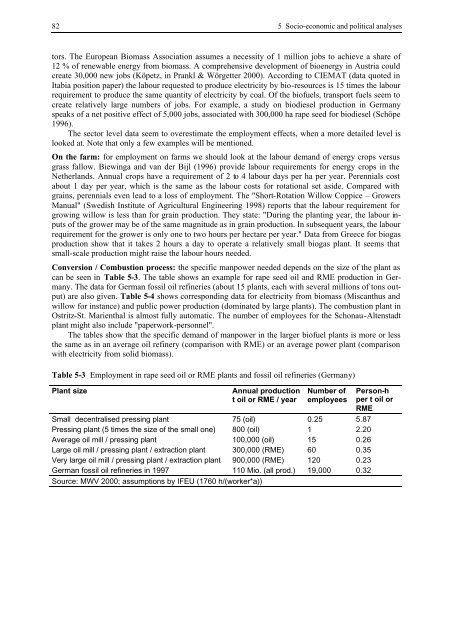BIOENERGY FOR EUROPE: WHICH ONES FIT BEST?
BIOENERGY FOR EUROPE: WHICH ONES FIT BEST?
BIOENERGY FOR EUROPE: WHICH ONES FIT BEST?
You also want an ePaper? Increase the reach of your titles
YUMPU automatically turns print PDFs into web optimized ePapers that Google loves.
82 5 Socio-economic and political analyses<br />
tors. The European Biomass Association assumes a necessity of 1 million jobs to achieve a share of<br />
12 % of renewable energy from biomass. A comprehensive development of bioenergy in Austria could<br />
create 30,000 new jobs (Köpetz, in Prankl & Wörgetter 2000). According to CIEMAT (data quoted in<br />
Itabia position paper) the labour requested to produce electricity by bio-resources is 15 times the labour<br />
requirement to produce the same quantity of electricity by coal. Of the biofuels, transport fuels seem to<br />
create relatively large numbers of jobs. For example, a study on biodiesel production in Germany<br />
speaks of a net positive effect of 5,000 jobs, associated with 300,000 ha rape seed for biodiesel (Schöpe<br />
1996).<br />
The sector level data seem to overestimate the employment effects, when a more detailed level is<br />
looked at. Note that only a few examples will be mentioned.<br />
On the farm: for employment on farms we should look at the labour demand of energy crops versus<br />
grass fallow. Biewinga and van der Bijl (1996) provide labour requirements for energy crops in the<br />
Netherlands. Annual crops have a requirement of 2 to 4 labour days per ha per year. Perennials cost<br />
about 1 day per year, which is the same as the labour costs for rotational set aside. Compared with<br />
grains, perennials even lead to a loss of employment. The "Short-Rotation Willow Coppice – Growers<br />
Manual" (Swedish Institute of Agricultural Engineering 1998) reports that the labour requirement for<br />
growing willow is less than for grain production. They state: "During the planting year, the labour inputs<br />
of the grower may be of the same magnitude as in grain production. In subsequent years, the labour<br />
requirement for the grower is only one to two hours per hectare per year." Data from Greece for biogas<br />
production show that it takes 2 hours a day to operate a relatively small biogas plant. It seems that<br />
small-scale production might raise the labour hours needed.<br />
Conversion / Combustion process: the specific manpower needed depends on the size of the plant as<br />
can be seen in Table 5-3. The table shows an example for rape seed oil and RME production in Germany.<br />
The data for German fossil oil refineries (about 15 plants, each with several millions of tons output)<br />
are also given. Table 5-4 shows corresponding data for electricity from biomass (Miscanthus and<br />
willow for instance) and public power production (dominated by large plants). The combustion plant in<br />
Ostritz-St. Marienthal is almost fully automatic. The number of employees for the Schonau-Altenstadt<br />
plant might also include "paperwork-personnel".<br />
The tables show that the specific demand of manpower in the larger biofuel plants is more or less<br />
the same as in an average oil refinery (comparison with RME) or an average power plant (comparison<br />
with electricity from solid biomass).<br />
Table 5-3 Employment in rape seed oil or RME plants and fossil oil refineries (Germany)<br />
Plant size Annual production<br />
t oil or RME / year<br />
Number of<br />
employees<br />
Small decentralised pressing plant 75 (oil) 0.25 5.87<br />
Pressing plant (5 times the size of the small one) 800 (oil) 1 2.20<br />
Average oil mill / pressing plant 100,000 (oil) 15 0.26<br />
Large oil mill / pressing plant / extraction plant 300,000 (RME) 60 0.35<br />
Very large oil mill / pressing plant / extraction plant 900,000 (RME) 120 0.23<br />
German fossil oil refineries in 1997 110 Mio. (all prod.) 19,000 0.32<br />
Source: MWV 2000; assumptions by IFEU (1760 h/(worker*a))<br />
Person-h<br />
per t oil or<br />
RME

















